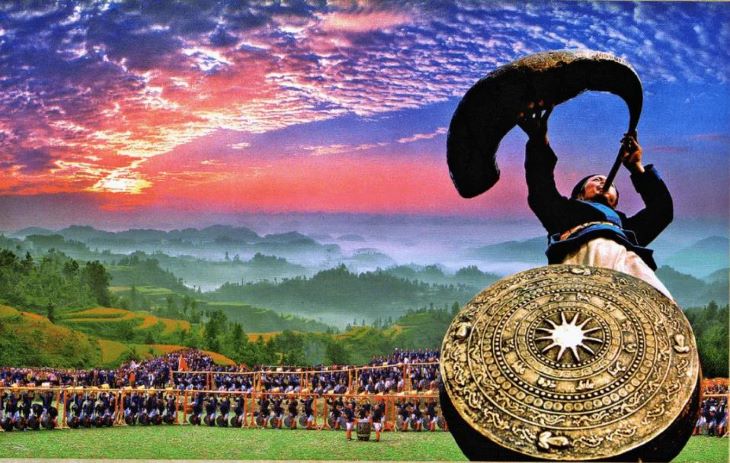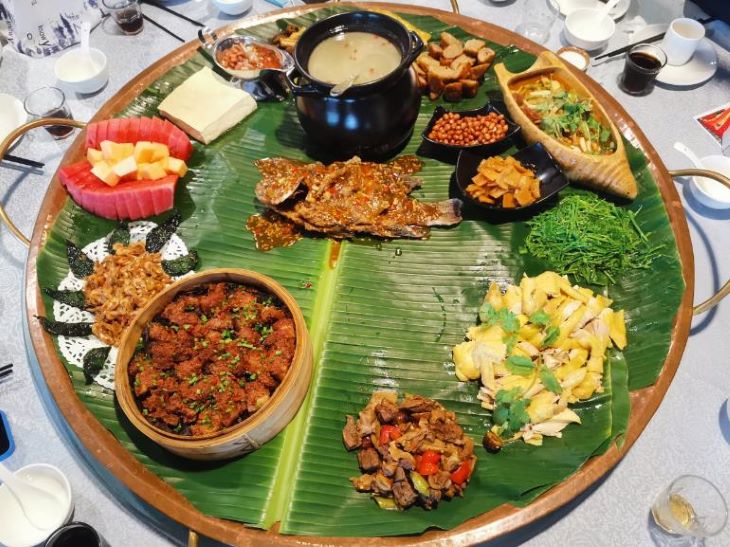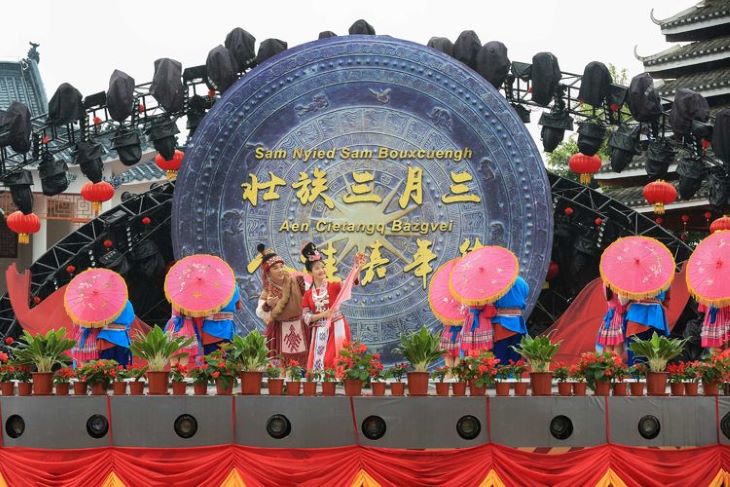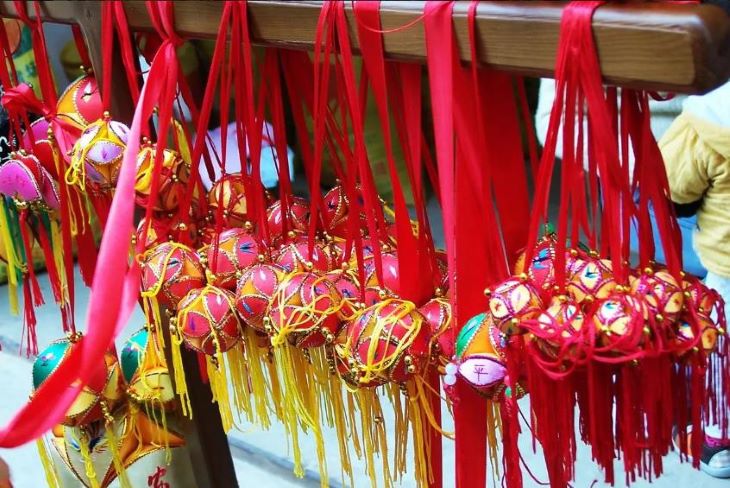It is known to us all that China is a nation with 56 people. While Han people remain the largest majority, Zhuang Chinese is the largest minority. If you are interested in Chinese culture or just want to know more about the Zhuang, you can get all you need in this post.
Zhuang people in China represent an essential part of Chinese culture. Learning about this ethnic group can help you delve deeper into Chinese culture.
Table of Contents
- Definition of the Zhuang People
- The Distribution of Zhuang Chinese
- The Origin of the Term “Zhuang” in China
- The History of the Zhuang Chinese
- Zhuang Languages
- Culture and Traditions of Zhuang People in China
- FAQ about China’s Zhuang People:
Definition of the Zhuang People
Called “Bourau” in English, Zhuang people is the traditional name of the people of “Zhuang” (“僮” in Chinese). The term “Zhuang” refers to a group of people with the same language, mostly distributed in Guangxi and Yunnan provinces.

It is said that the ancestors of the Zhuang people are the Yue whose origin, distribution, and customs remain unknown even now. In China, when people now say “Zhuang people”, they often mean the Zhuang Chinese in Guangxi Zhuang Autonomous Region (GZAR).
The Distribution of Zhuang Chinese
The Zhuang is distributed in 31 provinces, autonomous regions, and municipalities. But most of them are located in Southern China. Therefore, if you have the question “Where do the Zhuang people live in China?”, don’t hesitate to refer to the following answers.
The majority of the Zhuang people live in Guangxi Zhuang Autonomous Region with nearly 15 million Zhuang Chinese here, occupying 88% of the total Zhuang people.
In the autonomous region, such cities as Nanning, Chongzuo, Baise, Hechi, Liuzhou, Laibin, and Guigang are home to numerous Zhuang people.
In Wenshan Zhuang and Miao Autonomous Prefecture, Yunnan Province: 1 million (in 2000) Zhuang people.
In Lianshan Zhuang Yao Autonomous County, Guangdong Province: 420,000 Zhuang people.
In Jianghua Yao Autonomous County, Hunan Province: over 5,000 (in 2000)
In 2022, according to the National Population Census, the total number of Zhuang people is 16,926,38, the largest number in the list of the population of the Chinese ethnic minority.
Note:
Due to reasons like immigration in history, not only do Zhuang people locate in China but also the Zhuang are distributed in Vietnam.
In Vietnam, this people are called Daiyi people and Nong People, which can be the largest minority in this country. Like what this people do in China, they have passed on their traditions and customs in Vietnam for years while adapting to the local culture.
The Origin of the Term “Zhuang” in China
In Chinese historical books, “Zhuang” is written as “撞”. After the founding of the People’s Republic of China, “Zhuang” was written as “僮” in Chinese.
In 1965, in line with the recommendations of the Premier of the State Council and the agreement of the Zhuang Chinese, “僮” was changed to “壮” in Chinese, which means “healthy” in Chinese. From then on, “壮” was popularized.
It is worth noting that apart from the popularized name of “壮”, there are many names of the Zhuang among themselves, such as Buzhuang (“布壮” and “布越”). In the language of Zhuang people, “布” means “people”.
The History of the Zhuang Chinese
As the largest minority group, the Zhuang has undergone centuries of unification attempts. It is said that the history of the Zhuang dated back to the Warring States.
Originating in Sichuan and the lower reaches of the Yangtze River basin, the Zhuang moved to Guangxi and Yunnan provinces in Qin and Han Dynasties.
In different periods, Zhuang People have undergone different historical development:
- The Warring States
The latest historical records of the Zhuang people were found.
- Qin and Han Dynasties
Most Zhuang people moved to Guangxi and Yunnan provinces.
- The Tang Dynasty
Zhuang people living in Guangxi and Yunnan provinces defended against the expansion of the Han Dynasty and established their empires.
In the Tang Dynasty, the Zhuang rebelled against the Tang Dynasty by supporting the Nanzhao Kingdom. Then, the Zhuang people gained control in western Guangxi and Yunnan.
- The Song Dynasty
The Zhuang people were conquered.
- The Yuan and Qing Dynasties
The Zhuang people have gradually been Hanized in that the majority people of Chinese are Han. After the Han people conquered them, the Zhuang have been exposed to the customs and traditions of the Han.
- Later periods:
Under the regulations of the Communists, Zhuang people supported the Communist’s policies like land reform.
- After the Founding of the People’s Republic of China:
The agriculture, education, infrastructure, and medical services of the Zhuang have been improved.
Zhuang Languages
There is a dual language system of the Zhuang people, the Zhuang Dai language. The Zhuang people speak the Sino-Tibetan language in different tones.
Language: the Zhuang language is rather similar to Thai and Lao. Because of the geography of the Chinese Zhuang people, their languages are close to that of Thailand and Laos.
Tones: There are nearly 8 tones in the Zhuang language. These tones are similar to the dialects of the Yue, namely, the tones in Cantonese in Guangdong province.
As the Zhuang people adapt to the culture of the majority, the Han people, have also borrowed many words and tones from mandarin.
Culture and Traditions of Zhuang People in China
Different peoples tend to cultivate different cultures and traditions throughout historical periods. For the Zhuang Chinese, there are different traditions regarding their diet, food, and clothing and cultural factors about their festivals and architecture.
The following paragraphs will elaborate on the traditions and culture of the Chinese Zhuang people:
Food:

The Zhuang people were one of the first to cultivate and grow rice, and with a well-developed rice culture, rice has naturally become a staple food for the Zhuang people.
Rice is prepared in a variety of ways, including steaming, boiling, stir-frying, stewing, and deep-frying. Various kinds of rice, rice porridge, rice flour, rice cakes, patties, rice dumplings, and dumplings are the Zhuang people’s daily favorite foods.
If mixed with other ingredients, rice can also be made into many more tasty and nutritious foods, such as eight-pot rice, eight-pot congee, bamboo rice, pumpkin rice, and “colored glutinous rice”.
The Zhuang people living in the arid mountainous regions mainly eat maize in that rice is not suitable for cultivation.
The Zhuang people love to eat fish, clams, snails, and mussels, the mushrooms and fruits of the mountains and forests, cicadas, snakes, birds, and animals.
Clothing:
Most of the clothing of the Zhuang is the same as that of the Han Chinese, but in the villages of western Guizhou, especially among middle-aged and elderly women, they still wear their ethnic clothes.

In north-western Guangxi, middle-aged and elderly Zhuang women mostly wear collarless, left-overlapping, embroidered piped clothes and piped, wide-legged trousers, with an embroidered waist, pleated skirts, and embroidered shoes underneath, and prefer to wear silver jewelry.
In south-western Guangxi, around Longzhou and Pingxiang, Zhuang women still wear collarless, left-overlapping black tops, with black handkerchiefs wrapped around their heads in the shape of squares, and black wide-legged trousers underneath.
The religion of Zhuang Chinese:
Most Zhuang people may worship more than one God, so they tend to be polytheistic. Usually, the Zhuang people worship their ancestors, and they often pray to everything in nature, such as trees, birds, and stones.
The Zhuang Chinese choose to sacrifice to the god that they believe in, like the Kitchen God, the Water God, and the Sun God. They believe in the power of these gods in protecting their families and crops or livestock.
There is not a unified religious belief among the Zhuang people. But they learn from Taoism and Buddhism about religious activities, like praying and sacrificing to the sun and river.
Unlike religions such as Buddhism and Taoism, Zhuang people absorb the spirits of heroes and heroines in history into their religious beliefs. The local religious beliefs, thus, are supposed to protect locals from evil.
Marriage:
The Zhuang people follow the form of monogamous marriage. People can find love for themselves or allow their parents to arrange a marriage for them.
In traditional families of the Zhuang people, men have more rights than women in deciding the marriage of their sons or daughters. Even if some young people love themselves, their parents may likely interfere with their marriages as parents of other people do in China.
Special Festivals of the Zhuang:
Most of the Zhuang festivals are the same as those of the local Han Chinese. Traditional Han Chinese folk festivals such as Spring Festival, Lantern Festival, Spring and Autumn Society Day, Qingming, Dragon Boat Festival, Mid-Autumn Festival, Chongyang, and New Year’s Eve are also Zhuang festivals of the year.
Especially, unlike the Han people and many other peoples, the Zhuang have regular folk song gatherings several times a year, with the “March 3 Song Festival” being the grandest. It means that the Zhuang population tends to hold a gathering on March 3 (Chinese calendar) to sing as they wish.

Moreover, the “Ghost Festival” or the “Ancestors’ Festival”, is a major festival second only to the Chinese New Year. The main activities of this festival are ancestor worship and ghost worship. The Zhuang tend to sacrifice their ancestors with chicken, duck, and other food.
Handicrafts of Zhuang People:
For the Zhuang people, along with its special festivals and other cultural elements, there are some unique handicrafts with special meanings.
For example, Xiuqiu, a kind of embroidery ball, can be a traditional handicraft that symbolizes happiness and love. Xiuqiu is actually a type of silk ball made of silk cloth and 12 petals. Xiuqiu is usually in different colors like red and yellow.

This kind of ball come to play when a girl wants to let a man know that he can pursue her. Thus, Xiuqiu represents positive feelings.
The Architecture of Zhuang People:
The houses of the Zhuang people are made of mud brick as well as wooden tiles. Usually located beside a hill, Zhuang houses stand by rivers and mountains.
On the mountain, Zhuang’s house stands on pilings. For this part, the houses of the Zhuang have some common with that of the Thai. As you can see below, these houses are often wooden with tile or thatch roofs. This architectural style of the Zhuang is also common in the houses of other peoples in the south of China.

FAQ about China’s Zhuang People:
Who are the Zhuang People in China?
It is a Tai-speaking ethnic group mostly living in the Guangxi Zhuang Autonomous Region in Southern China. Some live in Yunnan, Guangdong, Guizhou, and Hunan provinces. The Zhuang people are mainly located in China and Vietnam.
What Percent of China is Zhuang?
In China, 91% are Han people, 1.27% of Chinese are Zhuang, and 0.8% are Hui people.
What is the Position of the Zhuang People in Chinese 56 Peoples?
The Zhuang people are the largest minority group and the second largest people in China, only next to the Han people, the majority people in China.
Are Zhuang People Indigenous?
The Zhuang are the indigenous people in Guangxi, as the archaeological evidence shows. In other words, this people are not a settler or colonial population.
What Do Zhuang People Speak?
Today, most Zhuang people speak Mandarin. But these people have a unique language of Northern and Central Tai due to the deep connections between the Zhuang and Thailand.
